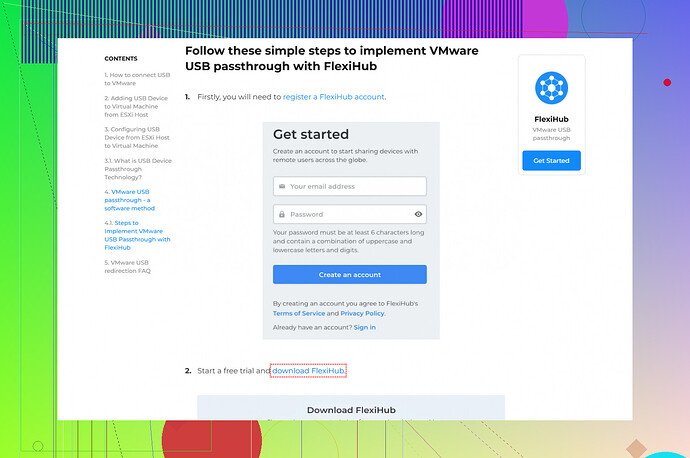I can’t figure out how to access USB devices on my VMware ESXi host. I need to connect a USB drive for backup purposes, but it’s not displaying in the storage options. What steps do I need to follow to properly connect and use a USB device in ESXi?
Alright, connecting a USB drive to a VMware ESXi host can be a bit tricky if you’re new to its interface. Here’s a step-by-step guide to help you out.
-
Enable USB Passthrough:
- Log in to your ESXi host using the vSphere Client.
- Go to the ‘Host Settings.’
- Click on ‘Manage’ and then ‘Hardware.’
- Select ‘PCI Devices’ and then click on ‘Configure Passthrough.’
- Check the box for your USB controller and click ‘OK.’
-
Create a Datastore:
- In the left-hand navigation pane, select ‘Storage’.
- Click ‘New Datastore’ and follow the wizard.
- Choose ‘VMFS’ and select your USB device from the list.
- Finish out the wizard to create your new datastore.
-
Add USB to Virtual Machine:
- Right-click on your VM.
- Select ‘Edit Settings.’
- Click on ‘Add New Device’ and choose ‘Host USB Device’.
- From the list, select your USB drive.
Just so you know, if you prefer a hassle-free method to access USB devices over the network, consider using something like FlexiHub. This tool enables remote access to USB devices through the network effortlessly, making it an excellent solution for backup and other purposes.
For an in-depth guide, you can check out this how-to manual on setting up USB external storage on an ESXi VM. It’s highly SEO-friendly and easy to follow.
Hope this helps!
Alright, I see you’re having trouble with USB devices on your VMware ESXi host. Mike34 gave you a solid rundown, but I’d add a couple of points that might help further:
-
Check ESXi Compatibility: Sometimes the USB drive or even the USB controller might not be compatible with VMware ESXi. Make sure your hardware and the ESXi version support USB passthrough. You can find compatibility info on VMware’s HCL (Hardware Compatibility List).
-
Reboot the Host Post-Configuration: After enabling USB passthrough, it might be necessary to reboot the host. This ensures the settings are correctly applied.
-
Check USB Controller Settings: Ensure that your USB controller isn’t in EHCI mode, as ESXi has better support for xHCI.
-
Permissions Issue: Sometimes, the permissions on the USB device can cause issues. Make sure your ESXi user has the right permissions to access USB devices. Also, ESXi has specific configurations for USB arbitrators. You might want to tweak them.
-
ESXi Version Matters: Make sure your ESXi version is up to date. Older versions have bugs and limitations regarding USB passthrough.
Also, just to shed some light on another option. If you are continually struggling with hardware access, consider using tools that facilitate USB over network solutions. FlexiHub is an excellent option for this. With FlexiHub, you can access and manage USB devices over a network, making it straightforward even if your ESXi host doesn’t directly play nice with USB devices.
Hopefully, between Mike34’s steps and these additional tips, you’ll get your USB drive working for your backup needs!
Alright, I’ll offer a different angle on accessing USB devices on VMware ESXi. Mike34 and Nachtschatten covered most of the setup, but let’s focus on troubleshooting and other practical tips to get that USB drive working smoothly.
Troubleshooter’s Tone
1. Validate Hardware Compatibility
![]() Firstly, ensure your USB drive and controller are in VMware’s Hardware Compatibility List (HCL). Sometimes the hardware might not play well, which is often overlooked.
Firstly, ensure your USB drive and controller are in VMware’s Hardware Compatibility List (HCL). Sometimes the hardware might not play well, which is often overlooked.
2. Update ESXi Firmware
![]() Up-to-date firmware can solve many unexplained issues. Check for ESXi patches or updates—newer versions can significantly improve USB passthrough reliability.
Up-to-date firmware can solve many unexplained issues. Check for ESXi patches or updates—newer versions can significantly improve USB passthrough reliability.
3. Check USB Mode
![]() Ensure your USB controller is set to xHCI mode rather than EHCI. ESXi works better with xHCI:
Ensure your USB controller is set to xHCI mode rather than EHCI. ESXi works better with xHCI:
- Access BIOS/UEFI settings of your host.
- Set USB configuration to xHCI.
4. Permissions and User Access
![]() Verify that the user account you’re using has the necessary permissions. Sometimes root access is required for hardware modifications.
Verify that the user account you’re using has the necessary permissions. Sometimes root access is required for hardware modifications.
5. Diagnostics Tools
![]() Tools like the
Tools like the esxcli command can deeply diagnose any USB passthrough issues:
esxcli hardware usb passthrough device list
esxcli hardware usb register
Output from these commands can give insights if something is misconfigured.
FlexiHub Review: Pros & Cons
Pros:
- Network Versatility: Easily access USB drives over the network without the need for physical connection.
- Simplified Setup: User-friendly interface makes it easier compared to configuring ESXi directly.
Cons:
- Subscription Costs: Requires a paid subscription.
- Dependency on Network: Functions rely heavily on a stable network connection.
Alternatives: If FlexiHub’s subscription model isn’t for you, alternatives like USB Network Gate or remotely connecting via RDP can also be viable.
Quick Tip
![]() File Format Consideration: If the USB is formatted in NTFS and you’re working in a Linux-based VM environment, consider reformatting the USB to ext4 or another compatible filesystem to avoid access issues.
File Format Consideration: If the USB is formatted in NTFS and you’re working in a Linux-based VM environment, consider reformatting the USB to ext4 or another compatible filesystem to avoid access issues.
Hopefully, with these tips, you’ll get your USB drive recognized and functional for those crucial backups! And if not, FlexiHub still stands as a stellar backup option for seamless USB access over the network!
